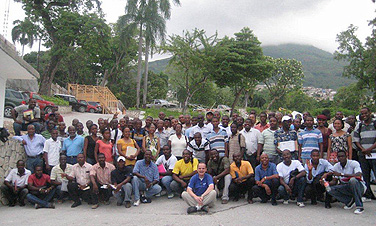News
Haitian engineers attending earthquake
seminars in record numbers

André Filiatrault, seated in front, poses with participants in the first UniQ-UB/MCEER Earthquake Engineering Seminar, held in May 2010.
-
 Print
Print -
 Comments
Comments
-
“Their attendance is critical. Both government and private sector engineers must be on the same page as they begin to reconstruct Haiti.”
The outcome of Haiti’s presidential election earlier this week will determine much of the country’s political future, but last week more than 250 Haitian architects and engineers took the future of Haiti’s reconstruction into their own hands when they attended the third UniQ-UB/MCEER Earthquake Engineering Seminar.
The sold-out seminar was the result of a partnership between Université Quisqueya (UniQ) and UB’s Multidisciplinary Center for Earthquake Engineering Research (MCEER) designed to teach Haitian engineers and architects how to incorporate seismic design into their work. It was the third in a series of seminars offered by MCEER since the January 2010 earthquake. To date, nearly 500—or 50 percent—of an estimated 1,000 engineers in Port-au-Prince have been educated through the MCEER programs.
For the first time, Haiti’s Ministry of Public Works, Transport and Communication (MTPTC) sent personnel to the seminar; 58 engineers from the ministry attended, supported by the United Nations Office for Project Services (UNOPS).
“Their attendance is critical,” says André Filiatrault, MCEER director and UB professor of civil, structural and environmental engineering, who is directing the UniQ-UB/MCEER seminars. “Both government and private sector engineers must be on the same page as they begin to reconstruct Haiti.”
Filiatrault notes that the rebuilding of Haiti will require a massive overhaul of its engineering practices, including building codes, licensing and examination procedures for architects and engineers, and more comprehensive engineering curricula.
“This partnership between MCEER and UniQ provides an important piece,” he says.
Seminar topics included post-earthquake building assessment, seismic design load calculations in Haiti and seismic design of buildings constructed with concrete, confined masonry and wood. A special program discussed the required properties and quality control and assurance of materials used for the seismic design of Haiti’s buildings, a “critical aspect of earthquake-resistant reconstruction in Haiti,” says Filiatrault.
Days after the January 2010 earthquake that killed more than 316,000 Haitians and destroyed much of the capital city, Filiatrault led a U.S. team of French-speaking structural engineers to assess the structural safety of hospitals and other structures critical to the immediate relief effort in Port-au-Prince. The team also set up a protocol for continued seismic assessments of buildings for the United Nations.
In addition to Filiatrault, instructors for last week’s seminar included Haitian native Pierre Fouché, a UB doctoral candidate in earthquake engineering, and J. Eric Karsh, principal, Equilibrium Consulting Inc., Vancouver, Canada. All instruction was in French.

Reader Comments